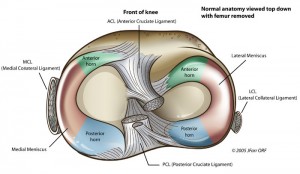
The meniscus is an amazing structure that sustains a tremendous amount of load over a lifetime. Its no wonder it wears out every now and then.
Fifty per cent of 50 year olds have meniscal tears in both their knees…and can have no symptoms and full function.
The meniscus is a dense type of fibrocartilage that occupies the space between the femur and the tibia. The meniscus deepens the surface of the tibia, allowing the rounded surfaces of the femur greater support during weightbearing and movement. The meniscus functions as a shock absorber, a lubricator and a stabilizer of the knee joint. During adolescence and young adulthood, the meniscus has a blood supply in what is referred to as the “hot zone”. If an individual tears the meniscus in this region, it is capable of healing. After the mid twenties, meniscal tears tend not to heal and either the individual can cope with them, or the knee becomes problematic.
The meniscus is often torn when an individual sustains an anterior cruciate ligament tear. Over 80% of people who have an anterior cruciate ligament tear will also have a tear of their meniscus. 
The meniscus gradually undergoes drying and desiccation throughout life. This causes it to become more brittle as we age. This accounts for the fact that up to 50% of men the age of 50, have horizontal cleavage tears in both of their knees.
The meniscus can also be torn in a violent fashion. Traumatic episodes such as getting tackled in football or intense rotational mechanisms, such as skiing injuries, can tear the meniscus. The classical manifestations of a meniscal tear are pain felt over the joint line, stiffness, as well as a sense of clicking, catching or locking. Locking is particularly indicative of a tear of the meniscus.
The meniscus is often torn when an individual sustains an anterior cruciate ligament tear. Over 80% of people who have an anterior cruciate ligament tear will also have a tear of their meniscus.
In bowlegged individuals, the medial meniscus is very vulnerable and in knockkneed individuals, the lateral meniscus is vulnerable to attrition and tearing.
In general, the diagnosis of a symptomatic meniscal tear is straightforward. Regional pain, clicking, catching and locking are the symptoms we would elicit. Physical examination will often reveal some fluid in the knee joint, as well as painful flexion or extension of the joint. There is often distinct tenderness over the joint line upon palpation.
There are some special tests designed to demonstrate cartilage tears on physical examination. Tests like the McMurray sign are not particularly sensitive or specific. X-rays can be done in the weightbearing position to determine whether or not there is the development of degenerative joint disease. Cartilage tears are often associated with degenerative joint disease. The weightbearing x-rays can also demonstrate if the knee joint has become asymmetrically narrowed, something that can be assisted by the prescription of an unloading brace.
Traditional wisdom has been that if the knee locks or catches then arthroscopic surgery is indicated. A recent study has called this logic into question indicating that even after arthroscopic surgery, people with meniscal tears often still have catching and locking of the knee joint. About a decade ago, most people who had any kind of degeneration of their joint would undergo arthroscopic surgery. A landmark study published in the New England Journal of Medicine indicated that people who had a so-called arthroscopic cleanout of a degenerative knee, did worse than those who did not have the cleanout. This was a major study that had placebo controlled surgical procedures done, so it was a very high quality study. This has changed the way many of us practice in terms of recommending surgery for degenerative meniscal tears.

When it comes to the meniscus, old is over 25….
There are several different types of tearing of the meniscus. So-called horizontal cleavage tears are very common, age-related, and may not be associated with any significant impairment. So-called bucket handle tears are often associated with trauma and often associated with locking of the knee joint. They frequently find their way to surgery. There are radial tears and they have an intermediate prognosis between cleavage tears and bucket handle Meniscal tears will often respond to conservative measures. Reducing the joint fluid with ice, topical diclofenac and modified activity often help. Learning which activities aggravate the meniscus is important. Usual culprits are deep squatting and pivoting. Unloading braces can mitigate the effects of a torn meniscus and other biomechanical interventions such as foot orthotics can help.
In general, many patients who have torn menisci can have high function without much pain. The meniscus is another good example of the notion of a perturbation of a joint leading to difficulty that will settle with appropriate care.
.
Meniscal tears are another example of the fact that an MRI does not always answer our questions.
